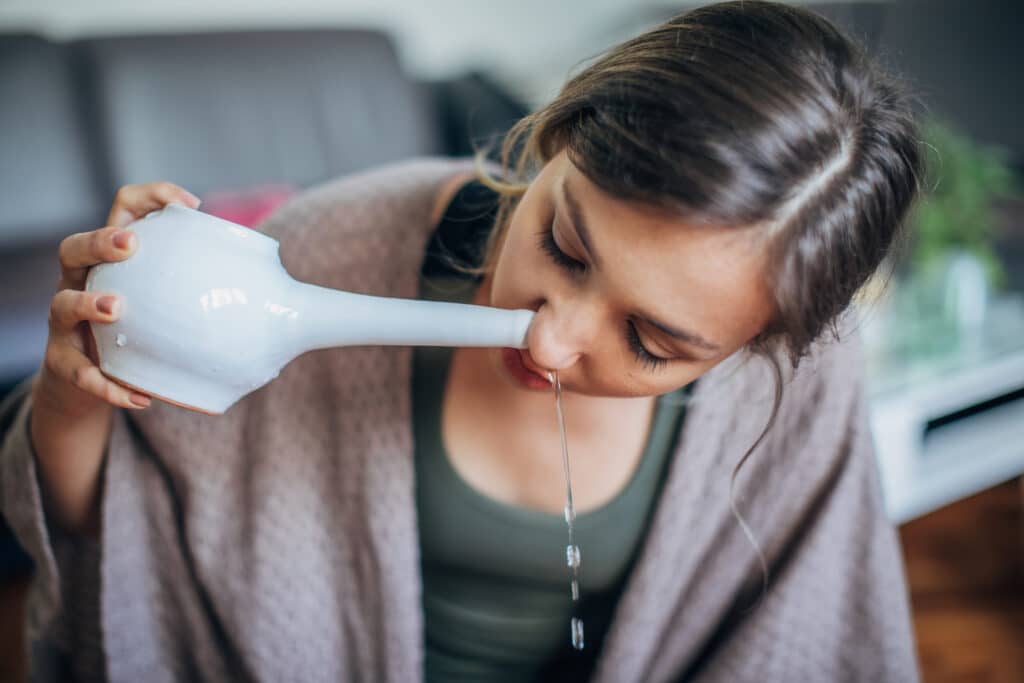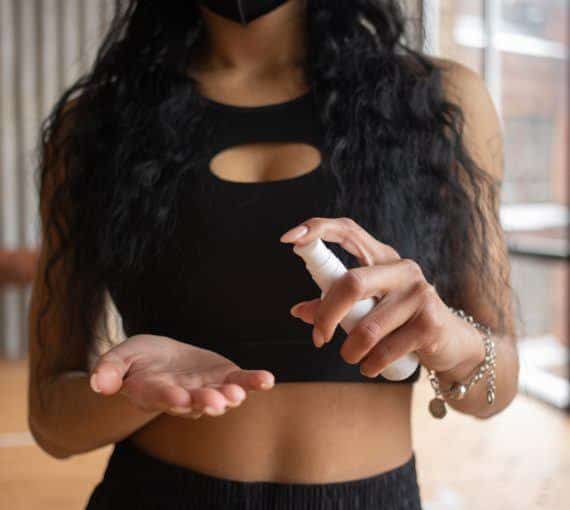
A neti pot is the oldest and most common nasal irrigation device.
Colds and flu can occur throughout the year. But they’re more common during chillier months. Frigid dry air, more time spent indoors in close contact with other people, holiday parties and temperature changes are opportunities for viruses to spread. The uncomfortable results: nasal congestion and runny noses. Relieve your sinuses by trying a DIY saline solution nasal rinse!
Nasal irrigation: an ancient practice
The neti pot, a small container with a long spout (like a teapot) has a long association with nasal irrigation. Its name reveals its ancient history.
“Jala neti” (Sanskrit for “cleansing the nose with water”) is one of the six purifying techniques in the Hatha Yoga Pradipika. The earliest record of nasal irrigation has been found in India (although historians believe that coastal dwellers sniffed ocean salt water into their noses to relieve congestion) as an Ayurvedic practice beginning in the 11th to 15th century to prepare the body and mind for meditation.
Traditionally, neti pots are made of ceramic but their commercialization in North America in the 21st century means many are mass manufactured in plastic. While both materials are (often) recyclable, ceramic is Earth-friendlier.
Benefits of nasal rinsing
- Clears nasal passages. Excess mucus, allergens and irritants cleared from the nasal passages alleviates congestion and improves breathing.
- Reduces sinus infections. Regular nasal irrigation may reduce the frequency and severity of sinus infections by flushing out bacteria and preventing them from multiplying in the sinus cavities.
- Relieves allergy symptoms. Beyond cold and flu season, nasal irrigation can be beneficial and provide relief to people with allergies. It helps remove allergens from the nasal passages, reducing symptoms like sneezing, itching and congestion.
Benefits of making your own nasal saline rinse
- It’s easy — invite the children in your life to help!
- Saves money.
- It’s a zero-waste alternative to over-the-counter solutions sold in stores.
- Avoids preservatives some over-the-counter solutions contain.
Two DIY saline solution recipes
First ensure your nasal rinse device is ready. Use a neti pot, bulb syringe or squeeze bottle made for this purpose (check your local pharmacy or health store). Disinfect your device with white vinegar or isopropyl alcohol before use.
Read labels! The best salt for a nasal rinse is non-iodized, such as pure sea salt or kosher salt. Iodized salt can be toxic to the nasal mucosa (the tissue that lines the nasal cavity).
Note: If you have chronic sinusitis or any other specific nasal condition, nasal irrigation may not be suitable for you. The ideas and advice shared here should not replace a doctor’s advice, diagnosis or treatment.
Nasal rinse with only sea salt
In a clean jar, combine:
- 2.5 ml (½ tsp) sea salt
- 250 ml (1 cup) pre-boiled (10 minutes of boiling) and cooled water
Ensure salt is fully dissolved.
Source: Mieux vivre avec notre enfant
Nasal rinse with sea salt and baking soda
This recipe may be best if you have inflamed nasal mucosa. The baking soda gives a gentler sensation.
In a saucepan, boil for ten minutes:
- 1 litre (4 cups) tap water
- 1 ml (¼ tsp) baking soda
- 5 ml (1 tsp) sea salt
Source: Adapted by CHU Saint-Justine from the recipe developed by the American Academy of MD Allergy, Asthma and Immunology.
Store both prepared nasal rinse solutions in a clean, airtight container in the refrigerator for up to seven days. Take out only the amount you need for each use. Transfer that into a small clean bottle and let the solution reach room temperature before use.
How to do a sinus rinse
To adequately clean and drain your sinuses, you must pass the saline water from one nostril through the other. To do this, bend over the sink (or in the shower for a mess-free experience) and direct the solution into one nostril. Aim the stream towards the back of your head, not the top. The solution should flow into one nostril and out the other. Don’t panic if you swallow a little bit. Repeat with the other nostril.
If you’re performing a nasal rinse on a child, follow the same steps but make sure the child’s mouth is open. If you need examples or further directions, there are lots of online video tutorials.



